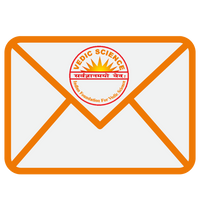Yoga ( योग )
Six philosophical thoughts, most often called as Shad Darshanas of ancient India are the help books to understand the different aspects of the comprehensive knowledge enshrined in the Vedas. These six Darshanas are not different from Vedas, but the part and parcel of the long Vedic tradition of India. That is why, these books are called as Aastika (theist) Darshanas as they are pro-Vedas or say follow the guidelines of the Vedas. The philosophical thoughts developed other than these were called as Naastika Darshanas or the philosophical thoughts developed disregarding the guidelines of the Vedas. The terms Aastika and Naastika denote respectively pro-vedas and anti-Vedas. Yoga deals with the spiritual/metaphysical aspect of creation. Its main objective is to help human beings to develop themselves to the extent as to realise the Supreme Power/God. Yoga is a science of psycho-engineering that engineers one's mind to realise oneself and ultimately realise God. This science is related with the human mind. That is why, the commencement of Yoga Darshana takes place with the succinct aphorism 'yogashchitvritti nirodhah', i.e. Yoga is the cessation of mental processes. This idea is already expressed in the Vedas. One can see through the 11th Chapter of Yajurveda to have an inkling on the germination of the ideas of Yoga. Some of mantras can be read like this:
yunjaanah prathamam manastatvaaya savitaa dhiyah.
agnerjyotirnichaayya p‚thivyaa adhyaabharat.
'To attain Moksha, harnessing, first of all, his mind, the practitioner should stretch his intellectual powers to receive the light of God and should rise above the mundane attractions'.
yuktena manasaa vayam devasya savituh save
svargyaaya shakttayaa.
'To attain Moksha, we should, with controlled mind, engage ourselves into divine or Godly or altruistic works'.
yuktvaaya savitaa devaant svaryyato dhiyaa divam
brihajjyotih karishyatah savita prasuvaati ten.
'Having controlled one's mind, a Yogi urges and focuses his senses towards divine works and through his intellect visulases the light of God'.
yunjate mana uta yunjate dhiyo vipraa viprasya brihato vipashchith.
vi hotraa dadhe vayunaa videka inmahee devasya savituh parishtutih.
'The yogis having controlled their minds, concentrate themselves on All knowing and Effulgent God. The God alone is All knowing. His lofty praise is attested in Vedas.'
yuje vaam brahma poorvya namobhirvishloka etu pathyeva sarah.
shrinvantu vishve amritasya putraa aaye dhaamaani divyaani tasthuh.
'O seekrs of Yoga, I connect you with the God existed prior to this creation. He was realised by past Yogis through prayer and meditation. All sons of God shall hear it, to attain salvation in the effulgence of God.'
Here it may be reminded that Human mind is the super computer of super computers, if it is processed in right direction with right guidance it can do miracles. This is what is the purpose and meaning of Yoga.
Just as the Yaantrika technology involves of kinetic and potential energies. Similarly Maantrika technology or mental technology developed in ancient India involved BhaavanÈ samskaara or psychic-energy. Yoga Darshana tells about as to how to pool the psychic energy and utilize it in achieving various goals. Yoga enables one to command over one's mental functions or processes. It may help to develop a particular type of feeling suited to life so as to develop a nishkaama karma feeling or a feeling where a particular action is taken only for the sake of doing that action and not for the sake of material gains; a feeling where one is not much worried about material gains, but is satisfied with the efficient performance of his act.
Thus Yoga philosophy had its tradition embedded in the Vedas. There are some scholars who think that Patanjali is the initiator of the idea of Yoga, but the fact is that Patanjali is the last scholar in the long tradition which preserved and documented this age old tradition in the common prevalent language of his period. Not only Yoga Darshana, but Patanjali is also assigned the authorship of Mahaabhaashya (a great commentary on Paanini's Ashtaadhyaayi and Charaka Samhitaa (tradtion of medical sciences developed in Vedic times).
Patanjali is often lauded as :
yogena cittasya, padenavaacaam malam shareerasy ca vaidyakena.
yo'paakarottam pravaram muneenaam Patanjalim praanjaliraanato'smi.
'Let me salute Patanjali who removed the infirmity of mind through Yoga, infirmity of body through medical science and infirmity of speech through his great commentary on grammar.'
The emperor Samudragupta of Gupta dynasty also assignes the authorship of all the three works of Grammar, Medicine and Yoga to PataNjali as :
kritam yena vyaakarana bhaashyam vacan shodhanam
dharmaaviyuktaashcharake yogaarogamushah kritaah
'Who composed a commentary on grammar that purifies the speech, he also composed Yogashaastra and Ayurveda for Yoga and treating the body of all diseases.'
mahaanandamayam kaavyam yogadarshanamadbhootam.
yogavyaakhyaanabhootam tadrachitam cittadoshaham.
'Yoga Darshana is a wonderful work. It is a commentary on the concept of Yoga and purifies the mind of all inconsistencies'.
Hereit may not be out of context to inform that Patanjali, the author of the above mentioned three works was known by different names viz. Gornadeeya, Shesharaaja, Naaganaatha, Churnikaara and Padakaara. Patanjali has not made any mention about himself in his works. As such his biography is in darkness. The time period assigned to Patanjali by the scholars like Yudhishthira Mimaamsaka etc. is between 1500 to 2000 years prior to Vikrama era, i.e. 3567 years to 4067 years ago.
After this brief introduction to Yoga, Yoga Dar„ana and its author Pata¤jali, it would be appropriate to inform our readers that Yoga enunciated in Vedas and Patanjali has eight parts. All these eight parts if practised in real spirit help develop a seeker into a high spirited Yogi. Endowed with divine powers. These eights parts are briefly described below:
1. Yama: A set of moral codes required for a seeker to attain Yoga
2. Niyama: Self ordained discipline
3. Asan: practice of different postures to maintain a healthy body and mind
4. Pranayama: Breath control
5. Pratyahara: Withdrawal of mind from sensory objects
6. Dharna: Concentration
7. Dhyana: Meditation
8. Samadhi: Merging with Universal Consciousness
